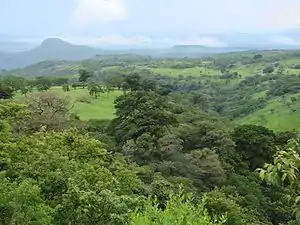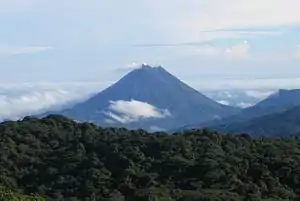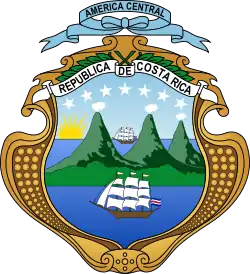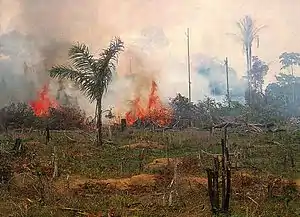Deforestation in Costa Rica
Deforestation is a major threat to biodiversity and ecosystems in Costa Rica. The country has a rich biodiversity with some 12,000 species of plants, 1,239 species of butterflies, 838 species of birds, 440 species of reptiles and amphibians, and 232 species of mammals, which have been under threat from deforestation.[1]

Causes and effects
Deforestation in Costa Rica has a serious impact on the environment and therefore may directly or indirectly contribute to flooding, desertification, sedimentation in rivers, loss of wildlife diversity, and the obvious sheer loss of timber. Since the end of World War II, approximately 80% of the forests of Costa Rica have disappeared.[2] Approximately 20,000 acres (8,100 ha) of land are deforested annually; in the 1990s the country had one of the worst deforestation rates in Central America.
As the population grew, the people of Costa Rica cut down the forests to provide for pastureland for cattle ranching to produce beef for the world market to raise revenue. Since the 1950s, approximately 60% of Costa Rica has been cleared to make room for cattle ranching. The problem was worsened because during the 1960s, the United States offered Costa Rican cattle ranchers millions of dollars in loans to produce beef. The deforestation of Costa Rica's tropical rain forests as in other countries is a threat to life worldwide with a growing rate of bananas there little room left for the apes costa rica of with a profound effect on the global climate.[2] Soil erosion has increased with deforestation with the topsoil washed away from the hills into the streams and out into the oceans, year after year.[2]

Over half of Costa Rica's existing forest cover today is under the protection of national parks, biological reserves, or wildlife refuges. However, the major problem in regards to deforestation is the privately owned plots which occupy the other half. Lenient laws on land and amendments to forestry law makes it easy to obtain logging concessions as owners exploit the land to maximise income.
As logging companies enter these forests to exploit them, they require access roads to transport the timber. While cattle ranching is by far the primary cause of deforestation in Costa Rica, banana plantations have also significantly contributed to the problem. Lowland rainforest has been most affected where 130,000 acres (530 km2) of previously forested land (primarily in the Atlantic and Northern regions) have been removed. Such industries have been synonymous with health risks, notably the high levels of toxic pesticides which affected thousands of plantation workers throughout Central America in the 1970s.
Pesticides used to grow bananas and other fruits such as mangoes and citrus fruit may enter the hydrological systems and contaminate the water. The removal of the forest to make way for these fruit plantations may also disrupt the nutrient balance in the soil and through monoculture exhaust the soils and render them unsustainable.[3]
Although most of the larger plantations in Costa Rica are owned by large companies, often multinationals, population pressure in Costa Rica has increased the demand for land among farmers who are forced to venture out onto new land to deforest and farm and compete over scraps of land.[4] While certain conservation laws have been passed in Costa Rica, the government lacks the resources to enforce them.
Decline of deforestation 1977-2004
The amount of Costa Rican land deforested annually has declined since 1977:[5]
| Year | Forest cleared (mi) |
|---|---|
| 1977 | 52,000 |
| 1983 | 43,550 |
| 1985 | 42,000 |
| 1987 | 32,000 |
| 1991 | 17,947 |
| 1996 | 18,000 |
| 2000 | 3,033 |
| 2004 | 4,737 |
Response

The conservation program in Costa Rica is particularly ambitious and is one of the most developed among tropical rainforest countries.[1] The country has a high level of biodiversity and different eco-zones, even within a small area. For example one of the country's protected areas is a strip of forest which runs for 40 miles (64 km) through nine ecological zones from sea level to 12,500 feet (3,800 m).[1] In 1995, the government introduced further protected areas, and a further 13% of the country was put under protection through privately owned preserves, particularly those with high biodiversity.[1]
The National Bamboo Project of Costa Rica was founded in 1986 to help decrease deforestation. The scheme aims at reducing deforestation by means of replacing timber with bamboo as a primary building material and providing low cost housing for Costa Rica's rural poor. By cultivating and building with Guadua species, indigenous giant bamboos, the National Bamboo Project was able to raise thousands of new homes for the poor, benefit the environment, and advance bamboo-based building technology.[6]
In a number of parts of Costa Rica, areas that were bare ten years ago have now been reforested.[2] Many non-government conservation organizations are working in the country to prevent deforestation and further these efforts of preservation and restoration. The country has also significantly taken advantage of ecotourism, taking the initiative to raise revenue through tourism while still protecting the forests.[1] Today, while deforestation rates have declined greatly from the 1990s with increased conservation efforts and such schemes, the remaining forests still face threats from illegal logging even in protected areas and land cleared for agriculture and cattle pasture in unprotected areas. Corruption exists in Costa Rica, but this problem is much lower than in many other Latin American countries.
Decentralization efforts

Decentralized decision-making is being practiced in Costa Rica to improve protected area management and biodiversity conservation. Costa Rica stands out among all developing tropical countries for its commitment toward environmental and natural resources issues. The central government has developed a protected area system that has given some kind of protected status to 25% of its national territory.[7] In the mid-nineties the Costa Rican government started to decentralize management and decision-making of all protected areas in the country to promote locally based biodiversity conservation governance. All protected areas were grouped in eleven regionally based administrative units and were labeled as conservation areas. The central government gave each conservation area the authority to exercise significant degrees of autonomy to design and implement policy for the management of the protected areas under their jurisdiction.[7][8]
See also
References
- "Costa Rica". Mongabay. Archived from the original on 2009-05-03. Retrieved 2009-04-21.
- "Deforestation-Reforestation". Discovery Travel World. Archived from the original on 2009-04-04. Retrieved 2009-04-21.
- Ellingson, L.J.; Kauffman, J.B.; Cummings, D.L.; Sanford, R.L.; Jaramillo, V.J. (2000). "Soil N dynamics associated with deforestation, biomass burning, and pasture conversion in a Mexican tropical dry forest". Forest Ecology and Management. 137 (1–3): 41–51. doi:10.1016/S0378-1127(99)00311-4.
- Harrison, Susan (March–April 1991). "Population growth, land use and deforestation in Costa Rica 1950-1984". Interciencia. 16 (2): 83–93.
- "Tendencia Historica de Deforestacion en Costa Rica". Sistema de Informacion de los Recursos Forestales de Costa Rica. Archived from the original on February 13, 2009. Retrieved 2009-04-21.
- "National Bamboo Project - Costa Rica". International Network for Bamboo and Rattan. Archived from the original on 2009-04-30. Retrieved 2009-04-21.
- Basurto, Xavier. "Taking a Comparative and Longitudinal View of Cross-Scale Linkages: The Decentralization of Biodiversity Governance in Costa Rica." Paper presented at the annual meeting of the American Political Science Association, Hyatt Regency Chicago and the Sheraton Chicago Hotel and Towers, Chicago, IL, Aug 30, 2007. 2009-05-27.
- Ferroukhi, Lyès, and Alejandra A. Schramm. "Progress and challenges of municipal forest management in Costa Rica." Archived 2010-08-08 at the Wayback Machine The International Development Research Centre, 2003. Web. 15 Oct. 2009.

